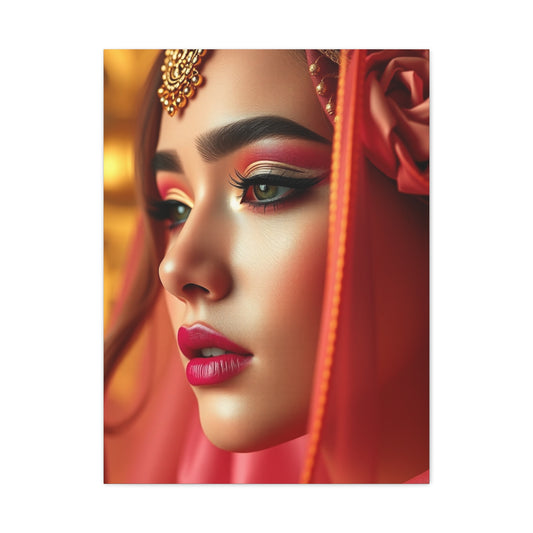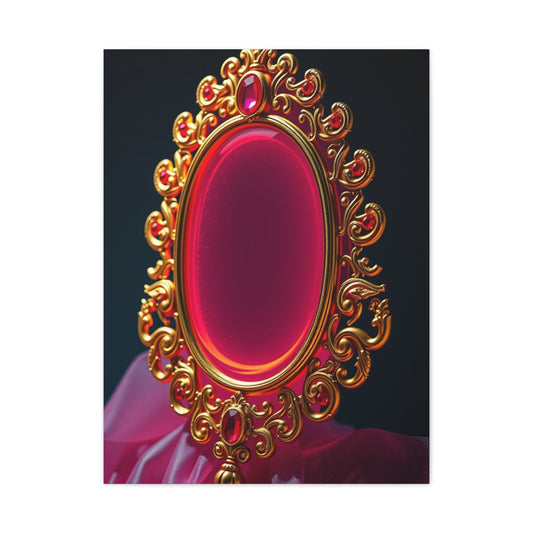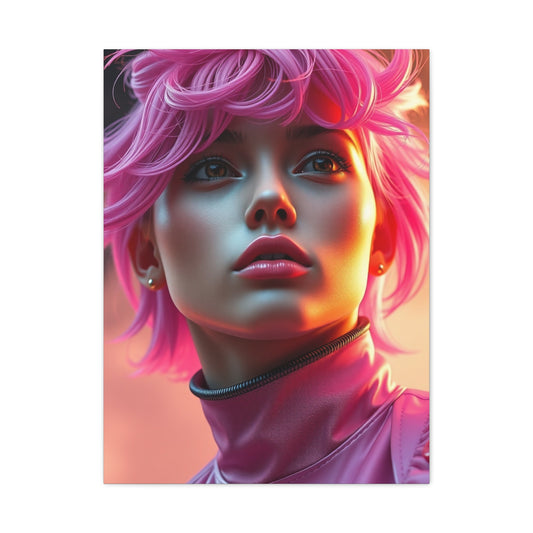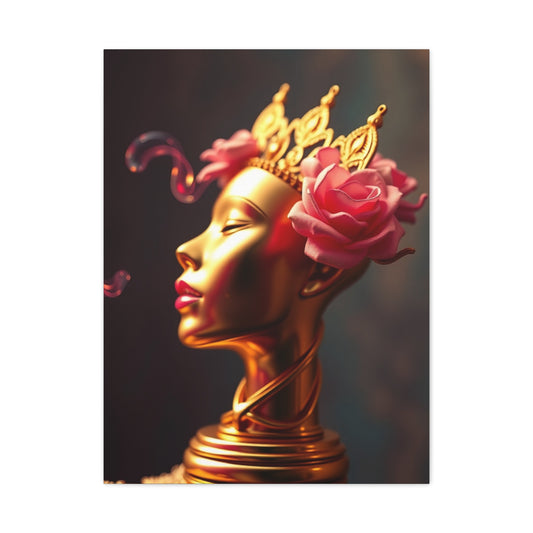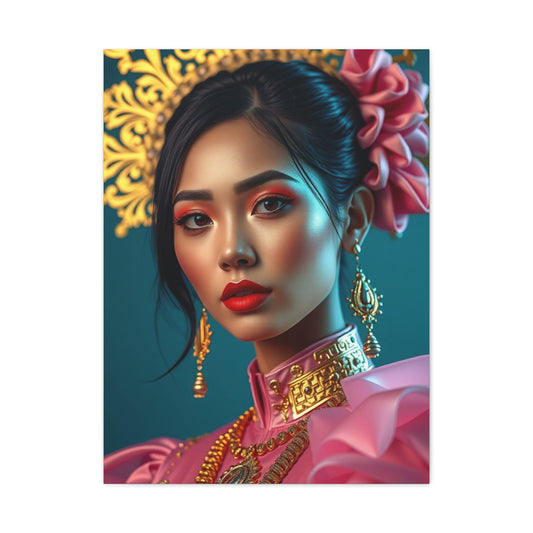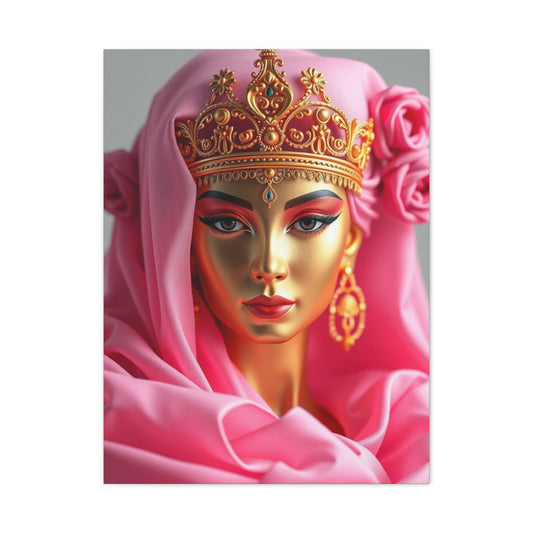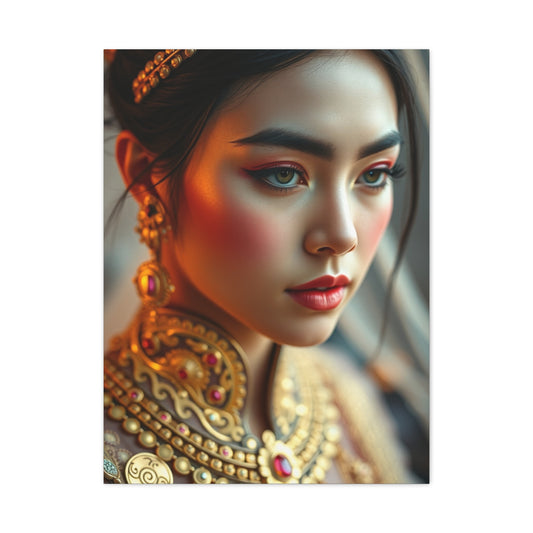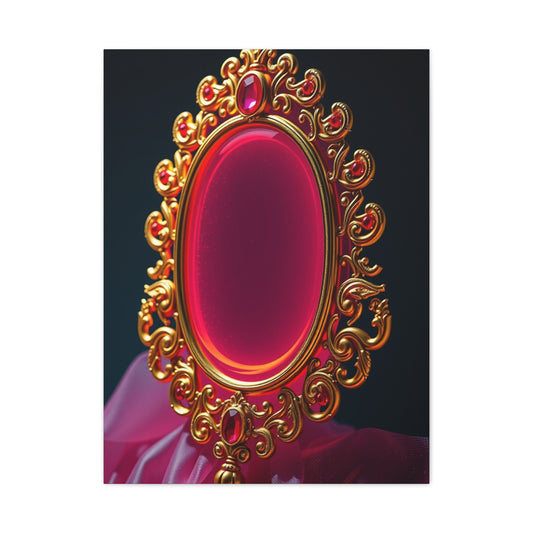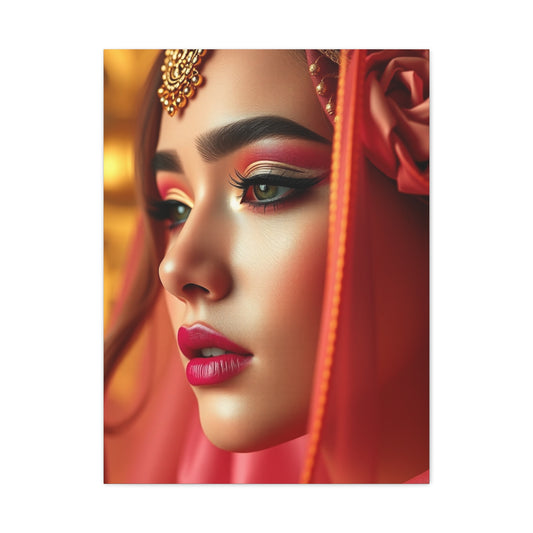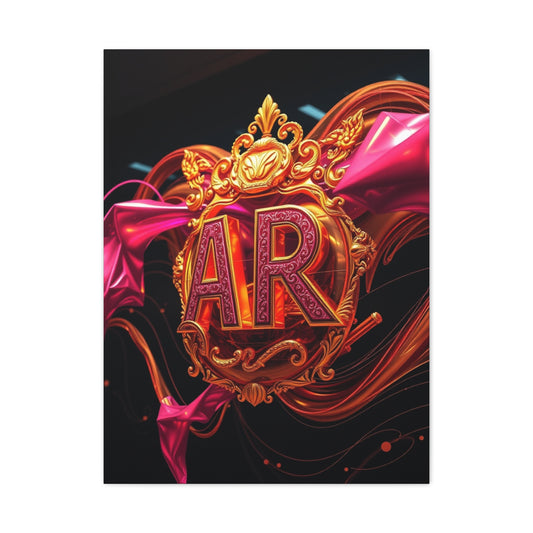Creative Ways to Style Pink and Gold Wall Art
Stepping into a room imbued with shades of pink is an experience that engages the senses in subtle yet profound ways. The color evokes warmth, charm, and an almost ethereal quality that can transform the mood of any space. From delicate blush to striking magenta, pink wall art serves as both a visual focal point and a source of emotional resonance, infusing interiors with personality and vivacity. Whether adorning a living room, bedroom, or even a home office, pink wall decor can be a versatile tool for designers and enthusiasts who wish to craft a space that feels both welcoming and distinctive.
The allure of pink lies in its inherent adaptability. Unlike other colors that may evoke a singular mood, pink encompasses a spectrum of emotional and aesthetic qualities. Soft pastel shades carry an air of tranquility, making them ideal for serene bedrooms or calming lounges. More vibrant tones, such as fuchsia or hot pink, exude energy and exuberance, perfect for spaces where creativity and liveliness are desired. The duality of pink allows it to function both as a gentle accent and as a dominant statement, depending on the design objective and the surrounding elements within the room.
The Psychology of Pink in Interiors
The impact of pink wall art goes beyond the visual; it interacts profoundly with human psychology. Pink has long been associated with notions of affection, tenderness, and optimism. Subtle pinks create a soothing environment conducive to relaxation, reflection, and gentle contemplation. Meanwhile, more intense shades stimulate vitality, creativity, and playful energy. Incorporating pink into wall art offers designers a unique way to modulate the emotional tone of a room without resorting to overtly loud or chaotic décor choices.
Psychologists suggest that colors like pink can influence mood, perception, and even interpersonal interactions. A space adorned with pink art may evoke feelings of warmth and approachability, making it an excellent choice for living areas where gatherings and social interactions occur. In private spaces such as bedrooms or home offices, the emotional resonance of pink can foster calm concentration or imaginative thinking. Therefore, the selection of pink wall art is not merely a stylistic decision; it is a deliberate act of curating atmosphere and ambiance.
Exploring Pink Hues and Their Effects
Pink encompasses an expansive spectrum of hues, each carrying a distinct visual and emotional signature. Dusty rose, a muted and sophisticated tone, imbues a space with subtle elegance. Its understated charm makes it suitable for rooms where soft light and contemplative serenity are desired. Peach-infused pinks, with their warm undertones, evoke a sense of coziness and intimacy, perfect for small bedrooms or quiet reading nooks. Vibrant pinks, including magenta and fuchsia, create visual drama and inject kinetic energy into otherwise neutral or subdued interiors.
Layering these shades within a single composition can yield an enchanting effect. For instance, a gallery wall combining dusty rose with hints of hot pink creates both depth and dynamism, capturing attention without overwhelming the senses. Pink wall art can also incorporate gradients, transitions, or abstract interplay between light and dark shades, producing a visual rhythm that guides the eye and enhances the spatial experience.
Choosing the Right Pink Wall Art for Your Space
Selecting pink wall art requires careful consideration of several factors. The size of the room, existing color palette, lighting, and furniture arrangement all influence how a piece will interact with its environment. In smaller rooms, lighter shades of pink can help reflect natural light, creating the illusion of openness and airiness. Larger spaces, conversely, offer the opportunity for bolder, more vibrant compositions that dominate the visual field and establish a definitive focal point.
The type of art—whether abstract, geometric, floral, or photographic—also plays a crucial role in determining the overall mood. Abstract pink canvases, with their fluid lines and dynamic shapes, can impart a sense of modernity and creativity. Geometric designs, combining structured forms with bold pink tones, introduce rhythm and symmetry while maintaining visual intrigue. Floral pink wall art, whether impressionistic or realistic, conveys softness and romanticism, perfect for spaces seeking warmth and intimacy. Each style presents unique opportunities to harmonize with furniture, flooring, and complementary décor.
Integrating Pink with Complementary Colors
Pink’s versatility is amplified when paired thoughtfully with other hues. For subtle elegance, pink harmonizes beautifully with neutral tones such as beige, cream, or soft gray. This combination produces a sophisticated and understated aesthetic, ideal for contemporary and classic interiors alike. When contrasted with deeper shades like navy blue or emerald green, pink gains a bold, luminous presence, energizing the space while maintaining balance.
In addition to traditional color pairings, pink can be integrated with analogous shades such as coral, peach, or lavender to produce a cohesive and melodious effect. The juxtaposition of these tones allows for nuanced transitions and visual storytelling within a room. Wall art that incorporates multiple pink shades alongside these complementary hues can serve as a unifying element, tying together disparate aspects of the décor and creating an immersive, harmonious environment.
Textures and Mediums in Pink Wall Art
Beyond color, texture and medium play a critical role in amplifying the allure of pink wall art. Canvas paintings offer a tactile, painterly quality, allowing brushstrokes and gradients to create depth and subtle movement. Mixed-media pieces, incorporating materials such as fabric, paper, or metallic pigments, add dimension and intrigue, transforming the wall into a multi-sensory experience. Sculptural wall art, even when painted pink, introduces a three-dimensional element, producing shadows and highlights that shift with changing light throughout the day.
The interplay of texture and tone can elevate a simple pink composition into a complex visual narrative. For example, a pink abstract canvas with raised elements can create a sensation of motion and depth, while a soft watercolor wash in varying pinks evokes serenity and grace. By exploring different textures and artistic mediums, homeowners can achieve a layered aesthetic that feels curated and bespoke rather than generic.
Gallery Walls and Pink Art Curation
One of the most engaging ways to display pink wall art is through a gallery wall. Curating multiple pieces, whether of varying sizes, styles, or shades, allows the walls to tell a cohesive yet multifaceted story. When arranging a gallery wall, consider balance, rhythm, and focal points. Large, bold pieces may anchor the display, while smaller accents can provide subtle contrasts and visual punctuation.
Pink gallery walls encourage experimentation. Abstract shapes can coexist with floral prints, photographs, or geometric designs. Using frames of different textures or complementary colors adds depth and richness, enhancing the viewer’s experience. Such arrangements can also allow for seasonal updates, where individual pieces can be swapped without dismantling the entire display. The result is a dynamic and ever-evolving visual narrative that maintains the vitality of the space.
Practical Applications of Pink Wall Art
Pink wall art is remarkably adaptable across various interior spaces. In living rooms, pink canvases can soften the atmosphere, counterbalance neutral furnishings, and provide a welcoming focal point. Bedrooms benefit from soft or muted pink tones that foster tranquility and restfulness, creating an environment conducive to relaxation. In workspaces, more vivid or abstract pink pieces can inspire creativity and provide a stimulating backdrop that encourages productivity and innovative thinking.
Dining areas, often overlooked as spaces for artistic expression, can be transformed through pink art. A bold pink abstract or floral canvas can elevate a room from functional to celebratory, imbuing mealtimes with energy and elegance. Even bathrooms, where color is typically subdued, can gain an unexpected sense of style with pink wall art, particularly when combined with reflective surfaces or soft lighting.
Balancing Pink with Furniture and Accessories
When integrating pink wall art, the surrounding furnishings and accessories must be considered to maintain harmony. Neutral furniture allows pink pieces to take center stage without visual conflict, while accessories such as rugs, cushions, or throws can subtly echo the artwork’s tones to reinforce cohesion. Layering pink accents throughout the space—mirrors, vases, or decorative objects—can create a sense of continuity and intentionality.
Color saturation and scale are also crucial. Large, intensely pink pieces may dominate a space if surrounding elements are similarly bold, potentially creating visual tension. Conversely, pairing vibrant pink art with subdued furniture and minimalist décor can allow the artwork to shine while maintaining equilibrium. Thoughtful placement and careful consideration of surrounding elements ensure that pink wall art enhances rather than overwhelms the space.
The Future of Pink in Interior Design
As design trends evolve, pink wall art continues to gain prominence in 2025 and beyond. Its versatility, emotional resonance, and aesthetic adaptability make it a favorite among contemporary designers and homeowners alike. The color’s spectrum—from gentle pastels to electrifying magentas—ensures that it can meet a wide variety of design intentions, whether subtle or bold.
Emerging trends indicate a growing interest in multidimensional and layered approaches to pink wall art. Combining textures, integrating abstract and representational elements, and experimenting with scale all contribute to a richer visual experience. As spaces become increasingly curated and intentional, pink wall art offers an opportunity to inject personality, warmth, and sophistication into interiors of all types.
Harmonizing Pink with Interior Color Palettes
Pink wall art offers a unique opportunity to experiment with color harmonies in interior spaces. Its adaptability allows it to blend seamlessly with a range of palettes, from soft neutrals to bold contrasts. When integrated thoughtfully, pink can transform a room, providing both warmth and sophistication without dominating the visual field.
For rooms seeking subtlety, pairing pink with light neutrals such as cream, beige, or soft gray creates a serene and elegant atmosphere. This combination allows pink elements to gently enhance the surroundings without overwhelming other design components. The subtle interplay between muted pinks and pale tones fosters a refined aesthetic, particularly suitable for bedrooms, reading nooks, or tranquil lounges. By softening edges and diffusing light, these gentle combinations can enhance spatial perception, making smaller rooms appear more expansive.
In contrast, vibrant pinks gain dramatic impact when juxtaposed with deeper hues like emerald green, navy blue, or charcoal gray. This approach generates a visual tension that captivates the eye while maintaining balance. Bold contrasts enable pink art to serve as a focal point, drawing attention and adding energy to living rooms, offices, or dining areas. The interplay between intensity and restraint within these color schemes results in a dynamic, multidimensional environment.
Layering Shades and Textures
Pink wall art becomes more compelling when multiple shades and textures are employed. A single pink canvas may offer subtle gradations from blush to fuchsia, creating depth and movement. Layering different pink tones across several pieces can produce a harmonious rhythm that guides the observer’s gaze, encouraging exploration and engagement.
Textures add a further dimension to pink art. For instance, a canvas with raised paint applications or embossed patterns offers a tactile richness, while watercolor gradients convey softness and fluidity. Mixed-media pieces, incorporating materials such as fabric, paper, or resin, introduce visual intrigue and variety. The combination of tonal layering and textural complexity ensures that pink art transcends mere color application, evolving into an immersive, multisensory experience.
Abstract Pink Art and Contemporary Expression
Abstract pink wall art occupies a central role in modern interiors. Its fluidity and unpredictability allow for interpretations that are both personal and transformative. Abstract compositions often blend multiple shades, brushstroke techniques, and geometric elements, producing a sense of motion and vitality. Whether displayed as a single commanding piece or as part of a curated gallery wall, abstract pink art can redefine spatial perception, creating an environment that feels both innovative and harmonious.
Geometric pink designs also offer structural appeal. Precise lines, overlapping shapes, and repetitive patterns introduce rhythm and order, balancing the emotional warmth of pink with intellectual clarity. This synthesis of structure and color is particularly effective in offices, creative studios, and contemporary living spaces, where the environment must inspire focus while remaining visually stimulating.
Floral and Nature-Inspired Pink Art
Floral motifs continue to be a popular avenue for pink wall art, providing a bridge between interior décor and natural aesthetics. From delicate watercolors to intricately detailed oil paintings, floral pink art imbues rooms with organic elegance. The use of soft pinks in petals, contrasted against subtle backgrounds, evokes serenity, romance, and sophistication.
Nature-inspired pink art need not be limited to florals. Abstract interpretations of landscapes, botanical patterns, or wildlife in pink tones can imbue interiors with a whimsical or meditative quality. By exploring the interplay between organic shapes and pink hues, homeowners can introduce a sense of harmony and balance, bridging the gap between human-made structures and the natural world.
Designing Pink Gallery Walls
Creating a gallery wall with pink art requires a thoughtful approach to composition and balance. Start by selecting pieces that complement one another in tone, theme, or style. Larger works can anchor the display, while smaller canvases or prints provide visual punctuation. The key is to maintain cohesion while allowing each piece to retain its individuality.
Mixing textures and mediums within a gallery wall enhances interest and depth. Canvas paintings, framed photographs, and prints can coexist, creating a multidimensional effect. Incorporating elements such as sculptural pieces or subtle three-dimensional accents can further enrich the visual narrative, transforming the wall into a dynamic focal point. Proper spacing and arrangement are essential, as the interplay between positive and negative space determines the wall’s overall impact.
Pink in Functional Spaces
Pink wall art is versatile enough to suit a variety of functional spaces, beyond traditional living areas. In home offices, vibrant pink abstracts can stimulate creativity and energize the environment, encouraging innovative thinking. Subtle pink accents, on the other hand, can maintain focus and serenity, preventing the space from becoming visually overwhelming.
In dining areas, pink canvases can elevate ambiance, fostering warmth and conviviality. A strategically placed floral or abstract piece can encourage engagement, conversation, and enjoyment, enhancing the social experience of the room. Even in bathrooms, pink art introduces a playful yet elegant touch, transforming utilitarian spaces into areas of aesthetic enjoyment. Smaller pieces, when thoughtfully positioned, can amplify the sense of intimacy and refinement in these more confined environments.
Complementary Furnishings and Accessories
Integrating pink wall art with furnishings and decorative accessories is crucial for achieving harmony. Neutral-colored furniture, such as gray sofas or beige armchairs, allows pink art to take center stage without competing for attention. Accessories—cushions, rugs, vases, and throws—can echo the artwork’s tones, creating a sense of continuity and cohesion.
Scale also matters when pairing art with furniture. Oversized pink canvases require subdued surroundings to avoid visual saturation, while smaller pieces can be accented with bolder or patterned furnishings to create an interactive dialogue between artwork and room elements. Strategic placement ensures that pink art enhances the interior rather than dominating it, fostering an environment of balance and sophistication.
Seasonal Adaptation of Pink Art
Pink wall art can be adapted to reflect seasonal changes or evolving interior themes. Spring and summer benefit from lighter, pastel shades, evoking freshness and rejuvenation. Autumn and winter, by contrast, may favor deeper, warmer pinks that convey coziness and comfort. Layering art with complementary décor, such as textiles, throws, or accent pieces, allows homeowners to refresh interiors dynamically without extensive renovations.
Furthermore, the versatility of pink permits experimentation with lighting. Warm lighting enhances softer pinks, creating intimacy, while cooler lighting accentuates brighter or more vibrant tones, highlighting their energy and dynamism. This adaptability ensures that pink art remains relevant across seasons, moods, and functions.
Innovative Approaches to Pink Art
Designers increasingly explore innovative approaches in pink wall art, experimenting with mixed-media techniques, unconventional canvases, and multidimensional elements. Sculptural wall panels, textile-based artwork, and layered resin pieces introduce new textures and visual experiences. These methods allow pink to transcend traditional flat compositions, transforming the wall into an interactive, immersive element of the interior.
The incorporation of metallic or reflective elements, even in subtle pink tones, can create movement and dynamism, as light interacts with surfaces throughout the day. Pink becomes a living component of the space, responding to environmental changes and enhancing the sensory richness of the interior. Such approaches invite observers to engage actively with the artwork, creating a more intimate and memorable experience.
Cultural and Historical Influences
Pink in art has evolved across cultural and historical contexts, lending depth and narrative potential to contemporary interiors. Traditionally associated with femininity and romance, pink has increasingly been embraced for its versatility, boldness, and expressive qualities. In modern design, pink often transcends these traditional associations, embodying creativity, individuality, and aesthetic experimentation.
Understanding these historical nuances can inform curatorial decisions in interior design. Choosing pink wall art with subtle nods to historical movements—such as impressionistic florals, abstract expressionism, or geometric modernism—enriches the narrative depth of a space. These references can imbue a room with both visual appeal and cultural resonance, offering layers of meaning that extend beyond surface aesthetics.
The Emotional Resonance of Pink
Ultimately, the strength of pink wall art lies in its emotional resonance. Its wide spectrum allows it to convey tenderness, warmth, playfulness, energy, and sophistication, often simultaneously. Carefully selected pink art can enhance a room’s ambiance, influence mood, and foster connection. The presence of pink encourages visual exploration, offering subtle cues that guide attention and evoke emotional responses.
Whether used as a central element or a supporting accent, pink wall art enriches interiors by creating a harmonious blend of color, texture, and narrative. It provides a medium for expression, enabling homeowners to curate spaces that reflect personal taste, lifestyle, and sensibilities.
The Elegance of Gold and Pink Wall Art
Combining pink with gold in wall art introduces a sense of opulence and sophistication that elevates interior spaces. While pink alone conveys warmth, playfulness, or serenity, the addition of gold accents introduces a luxurious dimension. This pairing allows for visual richness without overwhelming the room, creating a refined aesthetic suitable for a variety of interior styles—from modern minimalism to classic glamour.
Gold and pink wall art can take many forms. Abstract canvases might use gold leaf accents to highlight swirls of fuchsia or blush, creating depth and movement. Geometric designs can integrate gold lines or shapes within pink backgrounds, offering a structured yet luminous visual experience. Even floral or botanical motifs benefit from metallic highlights, where gold enhances the elegance of petals, stems, or leaves, producing a multidimensional composition.
The Psychological Impact of Gold and Pink
Gold and pink together create a powerful interplay of emotions. Pink continues to evoke warmth, tenderness, and optimism, while gold conveys luxury, prestige, and a subtle sense of grandeur. The human eye naturally gravitates toward metallics, and when paired with soft or vibrant pinks, gold can direct focus to key areas of a canvas or wall. This combination fosters feelings of joy, sophistication, and visual satisfaction, making it a compelling choice for focal pieces in living rooms, bedrooms, or dining areas.
The reflective qualities of gold interact with ambient light to enhance the overall luminosity of a room. Whether sunlight streaming through windows or soft artificial lighting, gold accents on pink art create dynamic visual effects, shifting subtly throughout the day. This movement adds life to static compositions and ensures that pink and gold pieces remain engaging long after their installation.
Styles of Gold and Pink Wall Art
Gold and pink wall art is versatile, encompassing a variety of styles that suit different tastes and interiors. Abstract compositions often feature irregular gold accents over gradients of pink, creating a sense of spontaneity and modernity. The metallic touches draw attention to specific areas of the artwork, enhancing contrast and depth while maintaining fluidity.
Geometric designs utilize precise gold lines or shapes against pink backgrounds to create rhythm and symmetry. These pieces offer a balance between creativity and order, ideal for offices, studios, or modern living spaces. Floral and botanical pink art, accented with gold, brings a delicate opulence to interiors. Soft pink petals outlined or veined in gold evoke romance and luxury simultaneously, making them suitable for bedrooms, hallways, or intimate lounges.
Integrating Gold and Pink Wall Art into Interiors
Successfully integrating gold and pink wall art requires attention to balance, lighting, and complementary décor. Neutral walls, such as white, cream, or gray, allow pink and gold pieces to stand out as focal points without competing with existing furniture or accessories. Gold accents are particularly effective when echoed in small decorative objects—mirrors, lamp bases, or picture frames—to create cohesion across the space.
In rooms with bold furnishings, pink and gold art can provide contrast, softening strong lines or colors while maintaining visual harmony. Conversely, in minimalist interiors, the metallic accents serve as a focal point, adding interest and texture without disrupting the overall serenity. The combination’s adaptability ensures that pink and gold wall art can enhance a wide range of aesthetic intentions, from playful vibrancy to sophisticated elegance.
Gold and Pink in Gallery Walls
Gallery walls offer an ideal canvas for exploring pink and gold combinations. Layering pieces with varying intensities of pink alongside subtle or bold gold accents creates visual depth and movement. Large canvases can anchor the wall, while smaller prints, framed photographs, or decorative elements provide contrast and variety.
In a curated gallery wall, gold and pink can be used to guide the eye, highlighting key pieces and establishing rhythm across the arrangement. Mixing different textures—canvas, metallic leaf, acrylic, or even textile-based art—adds dimensionality. This approach transforms the wall into a dynamic storytelling space, where the interplay of pink and gold conveys both emotional warmth and luxurious sophistication.
Functional Spaces for Gold and Pink Art
Gold and pink wall art is not limited to formal or decorative areas. It can be thoughtfully applied across a range of functional spaces to elevate atmosphere and inspire energy. In living rooms, a large pink canvas accented with gold can serve as a conversation piece, creating a welcoming and visually dynamic environment. In bedrooms, softer pink tones with subtle gold detailing introduce romance and intimacy without overpowering the room.
Home offices can benefit from abstract or geometric pink and gold art, where the metallic accents enhance focus and stimulate creativity. Even bathrooms, often overlooked for artistic expression, can be transformed with small canvases or prints featuring this combination, introducing a sense of elegance and warmth that contrasts with utilitarian fixtures. Dining areas, too, gain festive charm and visual interest from gold and pink art, fostering ambiance for gatherings and celebrations.
Pairing Gold and Pink with Other Colors
Gold and pink wall art can be paired with a variety of complementary colors to create distinct moods. Soft neutrals—beige, cream, or pale gray—allow the metallic and pink elements to shine, creating a subtle yet elegant look. Rich hues like navy, emerald, or deep plum provide dramatic contrast, emphasizing the opulence of gold while amplifying the intensity of pink tones.
For a harmonious and layered effect, analogous colors such as peach, coral, or rose can be incorporated. These complementary shades interact with pink and gold to create a cohesive and visually engaging composition. By thoughtfully selecting surrounding wall colors, furnishings, and accent pieces, gold and pink art can be seamlessly integrated into virtually any interior style.
Textural Dimensions of Gold and Pink Art
Texture plays a significant role in the appeal of gold and pink wall art. Canvas paintings with gold leaf detailing provide subtle raised surfaces that catch light and create depth. Mixed-media pieces incorporating metallic powders, acrylic gels, or fabric elements further enhance the tactile and visual richness of the artwork.
Three-dimensional or sculptural pieces in pink and gold introduce shadows and highlights that change with lighting conditions, producing dynamic effects. This multi-sensory dimension transforms the artwork from a static object into an immersive feature of the room, engaging viewers both visually and emotionally. Layering textures alongside tonal variations of pink and gold ensures that each piece offers continual discovery and intrigue.
Contemporary Applications of Gold and Pink
Modern interior design embraces gold and pink wall art for its ability to combine boldness with refinement. Abstract art in this palette often plays with irregular gold patterns across gradients of blush, fuchsia, or magenta. These compositions convey movement and energy, making them ideal for contemporary living rooms, open-concept kitchens, or creative studios.
Geometric interpretations provide structure, using gold lines or forms against pink backgrounds to establish visual order. This approach is particularly effective in office environments or minimalist spaces, where the balance between creativity and clarity is essential. Meanwhile, floral and nature-inspired compositions offer timeless elegance, blending delicate pinks with luxurious gold accents to produce an inviting and sophisticated ambiance.
Seasonal and Lighting Considerations
Gold and pink wall art responds beautifully to seasonal and lighting variations. Warm lighting enhances the metallic sheen of gold while amplifying the warmth of pink tones. Cooler light emphasizes contrast, bringing vibrancy to both pink and metallic highlights. Adjusting illumination throughout the day allows the artwork to remain visually dynamic, creating a living aesthetic that interacts with its environment.
Seasonal changes also offer opportunities to adapt the display. Spring and summer favor lighter pinks and softer metallic accents for freshness and luminosity. Autumn and winter invite deeper pinks paired with richer gold details, conveying warmth and intimacy. This adaptability ensures that gold and pink art remains relevant year-round while harmonizing with evolving interior themes.
Emotional and Cultural Resonance
The combination of gold and pink in wall art transcends mere decoration, carrying both emotional and cultural significance. Pink communicates warmth, affection, and vitality, while gold symbolizes prestige, abundance, and refinement. Together, they create a multi-layered emotional impact that resonates with viewers on multiple levels.
Historically, gold has been used in art to signify wealth, power, and divine influence. By integrating gold accents into pink wall art, contemporary interiors inherit a subtle nod to this legacy while embracing modern aesthetics. This interplay of history and innovation enriches the narrative depth of a space, making it visually compelling and culturally nuanced.
Practical Tips for Incorporating Gold and Pink
Successfully integrating gold and pink wall art requires mindful attention to scale, balance, and complementary elements. Oversized canvases with intense metallic detailing may dominate a room if surrounding furnishings are equally bold, while smaller pieces can serve as accent points to tie together décor. Accessories such as metallic frames, cushions, or decorative objects in gold tones can reinforce cohesion without overpowering the artwork.
Experimenting with different textures, finishes, and placements ensures that pink and gold art interacts dynamically with its surroundings. Layering abstract, geometric, and floral pieces can produce a multidimensional effect, transforming the wall into a focal point that engages both visually and emotionally. By balancing intensity, scale, and supporting décor, gold and pink wall art can elevate interiors to new heights of elegance and vibrancy.
Curating a Pink and Gold Gallery Wall
Creating a gallery wall with pink and gold wall art allows for personal expression while enhancing the visual narrative of a room. The key is balancing variety with cohesion, ensuring that each piece contributes to the overall story without creating visual chaos. Large canvases can serve as anchors, while smaller pieces and decorative accents offer rhythm, contrast, and texture.
Gallery walls provide a multidimensional experience. For instance, abstract pink canvases accented with metallic gold lines can coexist alongside floral prints featuring delicate golden highlights. Mixed-media pieces that incorporate fabric, resin, or embossed surfaces add depth, creating a tactile dimension that invites closer observation. A thoughtfully curated arrangement encourages viewers to move their eyes across the wall, discovering new details and nuances in each artwork.
Arranging Art for Maximum Impact
The arrangement of pink and gold wall art is as important as the artwork itself. Symmetry can lend a sense of order and sophistication, while asymmetrical layouts convey spontaneity and modernity. Vertical groupings can emphasize height, ideal for rooms with vaulted ceilings or tall walls, whereas horizontal arrangements expand the perceived width of a space.
Spacing between pieces is crucial to avoid overcrowding. Leaving adequate negative space allows each artwork to breathe, ensuring that the metallic gold accents and pink hues can shine without overwhelming the observer. For dynamic impact, consider layering frames of different textures or adding subtle decorative elements like mirrors or sculptural objects that echo the pink and gold palette.
Balancing Boldness and Subtlety
Incorporating pink and gold wall art requires careful attention to balance. Hot pink or fuchsia tones paired with prominent gold detailing can create striking focal points, but if overused, they risk overwhelming the space. To mitigate this, complement vibrant pieces with softer pink tones, muted metallics, or neutral surroundings.
Soft blush or dusty rose art with understated gold highlights can provide elegance without demanding excessive visual attention. Combining bold and subtle pieces within the same gallery or across multiple walls allows for layered interest. The interplay between intensity and restraint ensures that pink and gold art remains captivating, sophisticated, and versatile.
Integrating Furniture and Accessories
Pink and gold wall art reaches its full potential when harmonized with surrounding furniture and decorative objects. Neutral furnishings—such as gray sofas, beige armchairs, or wooden side tables—offer a canvas on which the pink and gold pieces can shine. Incorporating metallic accents in lighting fixtures, mirrors, or vases reinforces the theme and enhances cohesion.
Textiles can also complement the artwork. Cushions, throws, or rugs in soft pink or muted gold can create visual continuity, while patterns echoing geometric or abstract elements from the artwork reinforce design unity. Accessories should echo but not overpower the primary art pieces, preserving a sense of elegance and balance throughout the room.
Functional Applications Across Rooms
Pink and gold wall art is remarkably adaptable to various spaces, both functional and decorative. In living rooms, bold pink canvases with gold accents can act as conversation starters, transforming neutral walls into dynamic focal points. Softer pieces create warmth and intimacy, especially when paired with comfortable seating arrangements.
Bedrooms benefit from the calming influence of softer pink tones combined with subtle gold. These artworks create serene environments conducive to relaxation while adding a touch of sophistication. For home offices, abstract or geometric pink and gold art can inspire creativity and maintain an energizing yet refined atmosphere.
In dining areas, metallic highlights bring festivity and elegance, making mealtimes feel celebratory. Even bathrooms, often overlooked as artistic spaces, can gain charm through small pink and gold pieces. The reflective qualities of metallic accents, combined with the soft warmth of pink, transform utilitarian areas into unexpectedly elegant environments.
Exploring Modern and Eclectic Styles
Gold and pink wall art fit seamlessly into a variety of interior design styles. In modern spaces, abstract compositions or geometric designs provide structure, visual rhythm, and contemporary flair. Clean lines, open layouts, and neutral furnishings allow metallic and pink tones to stand out without visual clutter.
Eclectic interiors benefit from layered pink and gold pieces. Mixing different styles, textures, and sizes adds depth and personality. An abstract canvas can coexist with floral or vintage-inspired prints, while metallic elements tie disparate pieces together. The result is a curated chaos that feels intentional and visually stimulating.
Bohemian interiors also embrace pink and gold, using warm pinks, soft blush, or rose hues in combination with natural textures and eclectic décor. Metallic highlights in artwork elevate the space, adding sophistication without diminishing the relaxed, free-spirited ambiance typical of boho design.
Advanced Lighting Techniques
Lighting is integral to showcasing pink and gold wall art effectively. Warm, indirect lighting enhances the richness of pink tones and accentuates the reflective qualities of gold accents. Spotlights or track lighting can be used to highlight key pieces, drawing attention to texture, color gradation, and metallic shimmer.
Natural light further interacts with gold detailing, producing subtle shifts in brightness and hue throughout the day. In rooms with varying light sources, positioning art to optimize this interplay ensures a dynamic visual experience. Combining adjustable artificial lighting with natural illumination allows homeowners to modify mood and highlight specific aspects of pink and gold compositions as desired.
Seasonal and Thematic Adaptations
Pink and gold wall art can be adapted to align with seasonal or thematic decor. In spring and summer, lighter pinks combined with soft gold accents evoke freshness, renewal, and vitality. During autumn and winter, deeper pinks paired with richer golds convey warmth, intimacy, and a sense of luxury.
Thematic adaptations are also possible. For example, incorporating floral motifs during spring can echo natural growth and vibrancy, while abstract or geometric designs may complement modern, year-round interiors. By carefully selecting pieces that resonate with the current mood or season, homeowners can maintain a dynamic and evolving aesthetic without requiring a full redesign.
The Role of Texture and Medium
Texture is a defining element in pink and gold wall art. Metallic leaf, acrylic gels, or resin embellishments create surfaces that reflect light and add depth. Canvas pieces with raised brushwork or embossed patterns introduce dimensionality, engaging viewers in both sight and touch.
Mixed-media art, incorporating textiles, paper, or sculptural elements, enhances visual interest and makes each piece unique. The combination of textures with varying pink shades and metallic accents ensures that artworks remain visually compelling and emotionally resonant. Observers can experience new details from different perspectives, making the art interactive rather than static.
Curating Personal Narratives
Pink and gold wall art allows homeowners to infuse their spaces with personal narrative. Selecting pieces that resonate emotionally, thematically, or stylistically creates a sense of identity within the room. Abstract compositions can reflect creativity and imagination, floral motifs evoke nostalgia or serenity, and geometric patterns suggest precision and modernity.
By combining multiple artworks in curated arrangements, it is possible to tell a layered story. Each piece contributes to the overall narrative while retaining its individuality. Gold accents can serve as connective threads, guiding the eye and linking disparate elements, while pink tones provide warmth, cohesion, and emotional depth.
Maintaining Harmony and Proportion
To ensure that pink and gold wall art enhances rather than overwhelms a space, careful attention must be paid to harmony and proportion. Oversized artworks require subdued surroundings, while smaller pieces may benefit from complementary textures or accents nearby. The scale of furniture, wall dimensions, and room function all influence the visual balance of a display.
Using gold accents sparingly in tandem with pink tones prevents excessive visual stimulation. Conversely, strategically applied metallic highlights can draw focus to key areas and create contrast with softer pink hues. By maintaining proportion, layering textures, and balancing intensity, interiors achieve a sophisticated equilibrium that highlights the beauty of pink and gold art.
Emotional and Aesthetic Benefits
The combination of pink and gold in wall art provides both emotional and aesthetic benefits. Pink conveys warmth, comfort, and optimism, while gold evokes luxury, refinement, and a subtle grandeur. Together, they create spaces that feel vibrant yet elegant, playful yet sophisticated.
Gold and pink artworks invite contemplation and engagement. The interplay of color, texture, and metallic shimmer stimulates visual curiosity, providing a focal point that encourages viewers to explore nuances and appreciate detail. This combination enhances the ambiance of a room, making it emotionally resonant, aesthetically pleasing, and dynamically engaging.
Practical Tips for Incorporating Pink and Gold Wall Art
Successfully incorporating pink and gold wall art into interiors requires thoughtful planning and attention to detail. One essential approach is balancing intensity. Hot pinks with pronounced gold accents create striking visual focal points, but if overused, they can dominate a space. Pairing these bold pieces with softer shades of blush, rose, or dusty pink ensures visual equilibrium while maintaining sophistication.
Starting small can help gradually introduce pink and gold into your home. Begin with accent pieces, such as medium-sized canvases, prints, or framed art, and observe how the colors interact with existing furnishings and décor. As confidence grows, larger statement pieces or gallery walls can be introduced, transforming the room into a dynamic and visually engaging environment.
Harmonizing Wall Art with Furniture
Furniture choice plays a pivotal role in maximizing the impact of pink and gold wall art. Neutral-toned furnishings, such as gray sofas, cream armchairs, or beige storage units, allow the artwork to stand out without competing for attention. In contrast, incorporating subtle hints of pink or gold in upholstery, cushions, or throws reinforces cohesion across the space.
For rooms with vibrant furniture or strong patterns, pink and gold wall art can serve as a counterbalance, introducing harmony and visual respite. Oversized artworks are best paired with minimalist furniture arrangements, ensuring that the art remains the focal point without creating visual clutter. Conversely, smaller pieces can complement richly decorated interiors, weaving together patterns, textures, and tones into a cohesive whole.
Using Accessories to Amplify the Palette
Accessories are invaluable tools for enhancing the visual dialogue between pink and gold wall art and the surrounding space. Metallic vases, lamp bases, or mirrors echo the gold accents, reinforcing sophistication and visual continuity. Textiles in shades of pink, from blush to fuchsia, can be introduced through cushions, throws, or rugs, subtly reinforcing the artwork’s color story.
Decorative objects that combine texture, metallic sheen, or complementary hues provide additional layers of interest. Sculptural elements, ceramic pieces, or small furniture accents help bridge the visual gap between artwork and room elements. By repeating motifs, colors, and textures, homeowners can create a curated aesthetic that feels intentional and immersive.
Layering Textures for Depth
Texture is crucial in elevating pink and gold wall art beyond flat compositions. Canvas paintings with metallic leaf or raised brushwork create dimensionality that interacts with light. Mixed-media pieces incorporating resin, fabric, or embossed surfaces add tactile intrigue and encourage closer engagement.
Soft furnishings also contribute to textural layering. Velvet cushions, silk throws, and plush rugs in complementary pink or gold tones add warmth and richness, creating a sensory experience that extends beyond the visual. Combining diverse textures ensures the space feels multidimensional, inviting, and harmonious.
Creating Cohesion Across Rooms
Pink and gold wall art can serve as a unifying thread throughout a home. Repeating similar tones or motifs in different rooms creates a sense of cohesion without redundancy. For example, a living room can feature abstract pink and gold canvases, while the bedroom may showcase floral motifs or geometric interpretations in the same palette. Subtle continuities, such as gold-framed mirrors or pink accent cushions, tie the spaces together seamlessly.
This approach allows for variety while maintaining harmony. Each room retains its unique character and function while contributing to an overarching design narrative that reflects personal taste and aesthetic vision.
Incorporating Pink and Gold into Functional Spaces
Functional spaces such as home offices, kitchens, or dining rooms benefit from the warmth and energy of pink and gold art. In offices, abstract or geometric pieces stimulate creativity and focus, while subtle metallic highlights provide a sense of refinement. In kitchens or dining areas, artwork with vibrant pink tones and gold accents introduces liveliness and celebration, creating an inviting environment for family gatherings or entertaining.
Even utilitarian spaces, like laundry rooms or hallways, gain charm and sophistication when adorned with pink and gold wall art. Small prints or canvas pieces transform otherwise overlooked areas into visually engaging and aesthetically pleasing spaces.
Seasonal Adaptation and Versatility
Pink and gold wall art’s adaptability extends to seasonal and thematic changes. In spring and summer, light pinks with delicate gold detailing evoke freshness and vitality, complementing natural light and airy interiors. During autumn and winter, deeper pinks paired with richer gold accents create warmth, intimacy, and a sense of luxurious comfort.
Thematic adjustments are equally versatile. Abstract patterns may suit contemporary living spaces, while floral motifs bring seasonal freshness or romanticism. By thoughtfully selecting pieces that align with seasonal or thematic shifts, homeowners can refresh interiors without undertaking extensive renovations.
Advanced Lighting Techniques
Lighting significantly affects the perception of pink and gold wall art. Warm lighting enhances metallic accents and amplifies the warmth of pink tones, creating intimacy and elegance. Cooler lighting emphasizes contrast, highlighting both vibrant and soft shades while adding visual energy to the space.
Spotlights or directional lighting can draw focus to key pieces, emphasizing texture, metallic sheen, and tonal variation. Combining natural light with adjustable artificial illumination allows homeowners to curate mood, highlight details, and ensure that pink and gold artworks remain dynamic and engaging throughout the day.
Gallery Walls and Layered Arrangements
Gallery walls provide the perfect opportunity to showcase multiple pink and gold pieces in a single curated display. A mix of large canvases, medium-sized prints, and smaller decorative objects introduces rhythm and movement. Varying textures, from canvas to metallic embellishments, create dimensionality and encourage visual exploration.
Strategically arranging pieces—alternating abstract, geometric, and floral compositions—ensures diversity while maintaining cohesion. Metallic gold accents act as visual connectors, unifying disparate elements. Proper spacing, attention to scale, and layering textures are crucial for preventing overcrowding and maximizing impact.
Emotional and Aesthetic Impact
Pink and gold wall art enriches interiors not only visually but also emotionally. Pink conveys warmth, tenderness, and optimism, while gold introduces sophistication, luxury, and a subtle sense of grandeur. Together, they create environments that feel inviting, energizing, and aesthetically balanced.
These artworks stimulate engagement and contemplation. The interplay between color, texture, and metallic shimmer draws attention, encourages exploration, and enhances the emotional resonance of the space. Pink and gold art transforms walls into focal points that communicate personality, taste, and style.
Tips for Choosing the Right Piece
Selecting the ideal pink and gold wall art involves consideration of space, function, and existing décor. For small rooms, lighter pinks with subtle gold accents prevent visual overcrowding, maintaining a sense of openness. Larger spaces accommodate bold, oversized canvases or statement pieces that dominate the visual field while anchoring the room’s aesthetic.
Style also matters. Abstract art promotes creativity and modernity, floral motifs evoke romance and nostalgia, and geometric patterns convey precision and order. Matching the artwork’s tone and style with the room’s function ensures that pink and gold pieces enhance rather than conflict with the environment.
Maintaining Longevity and Visual Relevance
To ensure lasting impact, pink and gold wall art should be thoughtfully placed and complemented. Avoid overexposure to direct sunlight, which can fade pigments and dull metallic accents. Regular dusting or gentle cleaning of metallic surfaces preserves the artwork’s luster and vibrancy.
Incorporating adaptable display methods, such as gallery walls or modular arrangements, allows homeowners to refresh compositions over time. This ensures that pink and gold artworks remain visually engaging and emotionally resonant, accommodating evolving tastes, seasonal changes, and interior design trends.
Conclusion
Incorporating pink and gold wall art into interior spaces offers a unique blend of warmth, sophistication, and visual intrigue. Pink, with its versatility spanning soft blushes to vibrant fuchsias, brings energy, tenderness, and charm, while gold accents introduce luxury, depth, and refined elegance. Together, they create a harmonious dialogue that transforms walls into focal points, infusing rooms with personality and style. Whether through abstract compositions, geometric patterns, floral motifs, or curated gallery walls, pink and gold art enhances both functional and decorative spaces, from living rooms and bedrooms to offices and bathrooms. Thoughtful layering of textures, careful attention to scale, and complementary furnishings ensure balance and cohesion throughout a home. By embracing the interplay of color, light, and material, homeowners can craft interiors that are visually dynamic, emotionally resonant, and timelessly elegant, making pink and gold wall art a truly transformative element in contemporary design.


